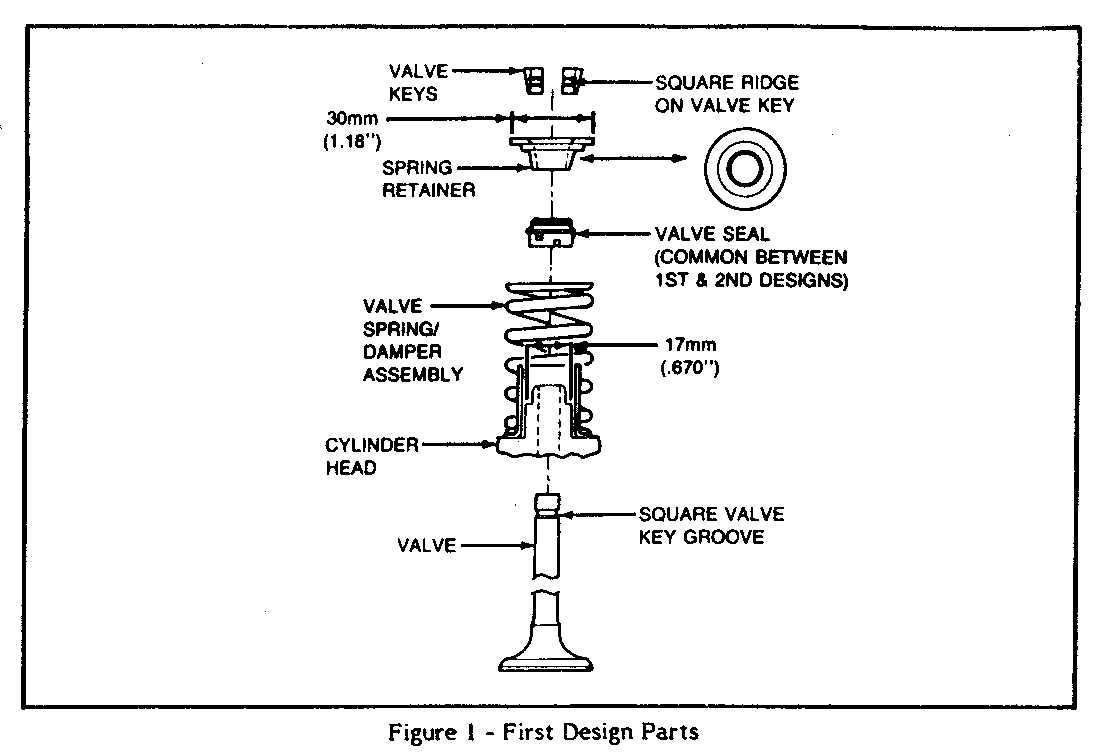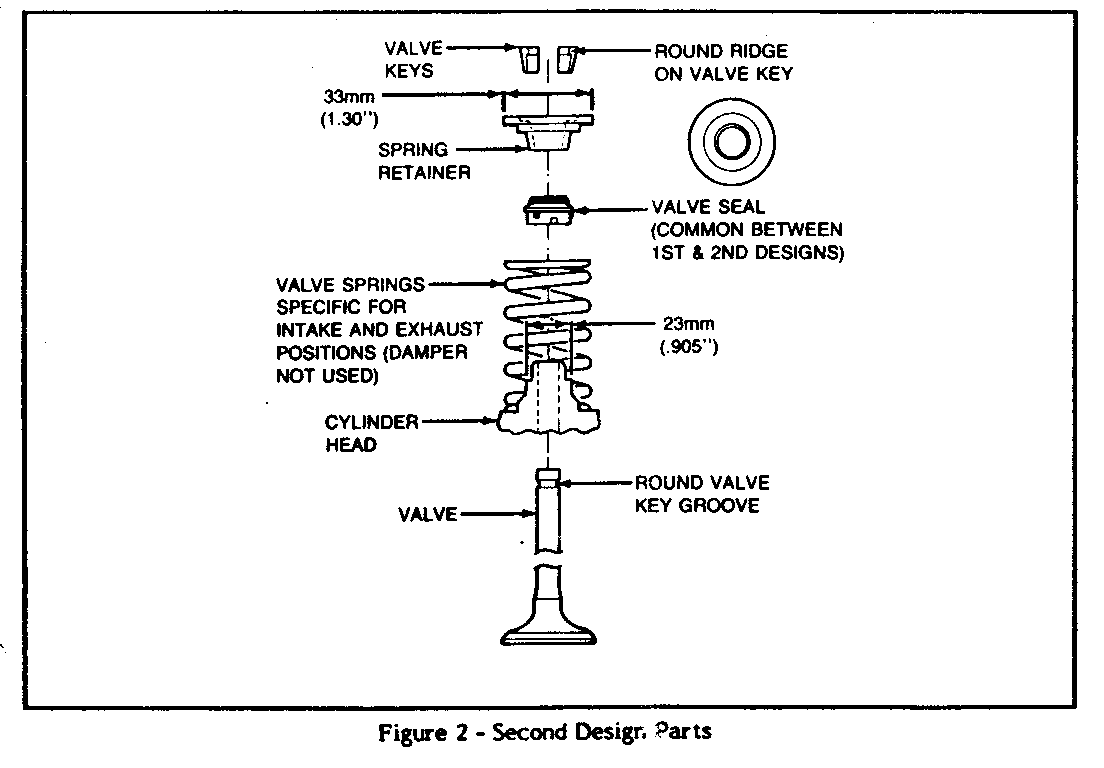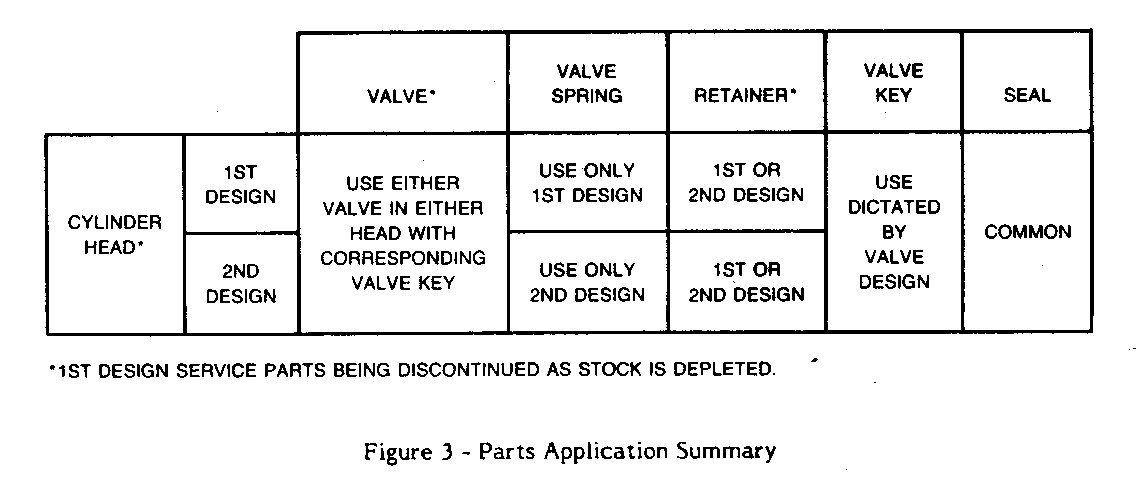HT4100 VALVE TRAIN NON INTERCHANGEABLE PARTS

VEHICLES AFFECTED: 1982-87 WITH HT4100 ENGINE
All 1987 production as well as 1982 - 1986 service engines produced after approximately January 1, 1987, will incorporate significant design revisions which affect cylinder head service of the HT4100 engine. The affected parts are:
- Cylinder head - Intake and exhaust valves - Valve springs - Valve spring retainer - Valve spring keys (keepers)
The initial or 1st design parts, shown in Figure 1, were used on all HT4100 engines produced between 1982 and 1986. All 1987 production engines and 1982 - 1986 service engines will be updated to the 2nd design configuration shown in Figure 2.
NOTE: 1st and 2nd design parts cannot be interchanged except by exact replacement of components, as described in this bulletin.
The following is a comparison of the design features of each component and definition of service implications.
CYLINDER HEAD
First design and 2nd design cylinder heads cannot be identified by a unique casting number. The difference between these parts is the diameter of the valve guide boss whose purpose is to locate the valve spring. Figures 1 and 2 define these dimensions. Use of 2nd design valve springs on the 1st design cylinder head will not provide the locating function and must not be done. Attempts to install the 1st design spring on the 2nd design head will result in an interference.
1982 - 1986 service parts (service engines as well as cylinder head castings) produced after January 1, 1987, will be updated to the 2nd design dimensions. 1st design parts are no longer being produced. If a 2nd design cylinder head is used to replace a 1st design head, 2nd design valve springs and retainers must also be installed. Combinations of a 1st and 2nd design head on the same engine is acceptable. The heads are in all other respects interchangeable.
INTAKE AND EXHAUST VALVES AND VALVE KEYS
First design intake and exhaust valves incorporate a square cut groove to accommodate the square ridge of the valve keys (keepers), Figure 1. 2nd design valves have a relocated and rounded groove and the corresponding valve keys have a relocated and rounded ridge, Figure 2. Obviously these important mating parts must be of like design. In all other respects these parts are identical. Installation of a 2nd design valve into the 1st design cylinder head is acceptable if 2nd design valve keys are also used. The 2nd design keys are copper plated for easy identification.
VALVE SPRINGS
The progressive rate 2nd design valve springs are specific for the intake or exhaust valve application (yellow - intake; black - exhaust). Because of their progressive rate characteristics a spring damper, as used on the 1st design spring, is not required. Because the damper is eliminated, the inside diameter of the 2nd design spring is larger than the earlier spring, thus the cylinder head valve guide boss is machined to a greater dimension to help locate the spring. For this reason valve spring design must match cylinder head style. See above information on cylinder heads. 2nd design springs should only be used with the 2nd design spring retainers.
VALVE SPRING RETAINER
The outside diameter of the 2nd design valve spring retainer has been increased (see Figure 1 vs. Figure 2) to better pilot the spring. The new retainer can be used with either valve spring. The 2nd design part will be phased into GMWDD stock as supply of the 1st design is depleted.
These revisions are the result of Cadillac's commitment to product improvement. To eliminate potential confusion resulting from these changes, refer to the appropriate GM Parts and Accessories Manual for the affected components.



General Motors bulletins are intended for use by professional technicians, not a "do-it-yourselfer". They are written to inform those technicians of conditions that may occur on some vehicles, or to provide information that could assist in the proper service of a vehicle. Properly trained technicians have the equipment, tools, safety instructions and know-how to do a job properly and safely. If a condition is described, do not assume that the bulletin applies to your vehicle, or that your vehicle will have that condition. See a General Motors dealer servicing your brand of General Motors vehicle for information on whether your vehicle may benefit from the information.
